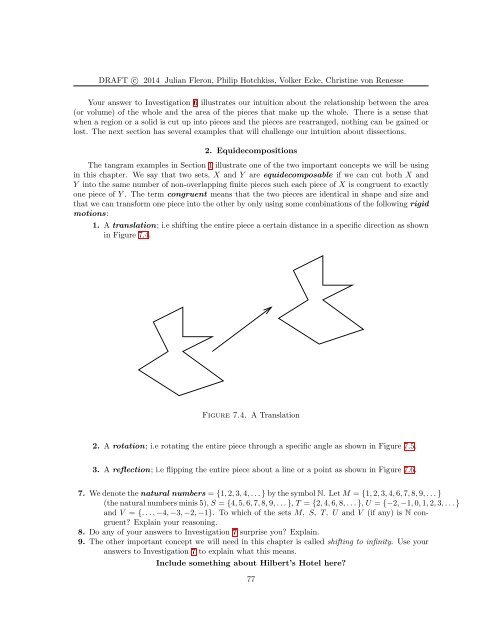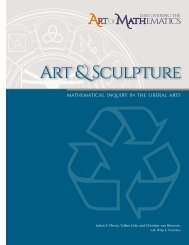calculus-2014-05-21
calculus-2014-05-21
calculus-2014-05-21
You also want an ePaper? Increase the reach of your titles
YUMPU automatically turns print PDFs into web optimized ePapers that Google loves.
DRAFT c○ <strong>2014</strong> Julian Fleron, Philip Hotchkiss, Volker Ecke, Christine von Renesse<br />
Your answer to Investigation 6 illustrates our intuition about the relationship between the area<br />
(or volume) of the whole and the area of the pieces that make up the whole. There is a sense that<br />
when a region or a solid is cut up into pieces and the pieces are rearranged, nothing can be gained or<br />
lost. The next section has several examples that will challenge our intuition about dissections.<br />
2. Equidecompositions<br />
The tangram examples in Section 1 illustrate one of the two important concepts we will be using<br />
in this chapter. We say that two sets, X and Y are equidecomposable if we can cut both X and<br />
Y into the same number of non-overlapping finite pieces such each piece of X is congruent to exactly<br />
one piece of Y . The term congruent means that the two pieces are identical in shape and size and<br />
that we can transform one piece into the other by only using some combinations of the following rigid<br />
motions:<br />
1. A translation; i.e shifting the entire piece a certain distance in a specific direction as shown<br />
in Figure 7.4.<br />
Figure 7.4. A Translation<br />
2. A rotation; i.e rotating the entire piece through a specific angle as shown in Figure 7.5.<br />
3. A reflection; i.e flipping the entire piece about a line or a point as shown in Figure 7.6.<br />
7. We denote the natural numbers = {1, 2, 3, 4, . . . } by the symbol N. Let M = {1, 2, 3, 4, 6, 7, 8, 9, . . . }<br />
(the natural numbers minis 5), S = {4, 5, 6, 7, 8, 9, . . . }, T = {2, 4, 6, 8, . . . }, U = {−2, −1, 0, 1, 2, 3, . . . }<br />
and V = {. . . , −4, −3, −2, −1}. To which of the sets M, S, T, U and V (if any) is N congruent?<br />
Explain your reasoning.<br />
8. Do any of your answers to Investigation 7 surprise you? Explain.<br />
9. The other important concept we will need in this chapter is called shifting to infinity. Use your<br />
answers to Investigation 7 to explain what this means.<br />
Include something about Hilbert’s Hotel here?<br />
77



